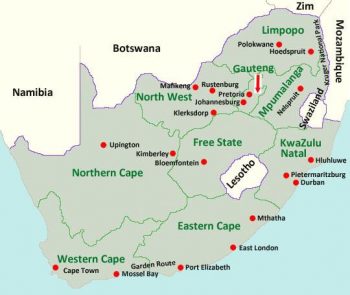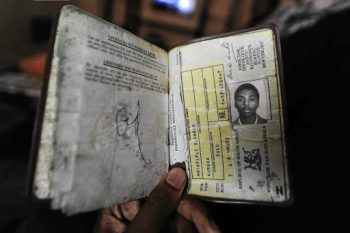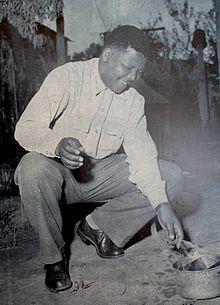First part of a 2 part series
Over 25 years ago now the people of South Africa won the struggle to end the Apartheid regime.(1) Nevertheless, even though it is now against the law, de facto racial segregation is still apparent. Moreover the capitalist assault on the majority of the population is blatant. The class struggle is all the more clearly perceptible as the main social progress has been the rise to capitalist status of a small minority of Blacks. While there are white and black capitalists, the majority of the non white population are still living in serious to extreme hardship. The South African population has reached about 58 million, of whom, to use the old Apartheid categories, 80% are « black », 9% are « white », 9% are « coloured » (mixed race) and 2.6% are « Asian » (descendants of Indian, Ceylonese, Indonesian, Malay and other groups from Asia).(2) South Africa is one of the places in the world where inequality is the most flagrant. The unemployment rate is around 27%. After playing a fundamental role in the struggle against Apartheid, the ANC (African National Congress) has been in power, in coalition with the South African Communist Party, for 25 years. The ANC-SAPC government has implemented neo-liberal policies with a dash of social policy. The harsh reality of such politics was tragically illustrated in Marikana in 2012, when the authorities sent in the security forces to break up a miners’ strike, killing 34 workers. Several present-day leaders of the ANC, including the capitalist Cyril Ramaphosa,(3) who has been president since 2018, were involved in the repression and had a vested interest in the private company that owns the mine in Marikana. All this is a far cry from the ANC’s glorious past. In a very difficult context, many resistance struggles are waged in the poor neighbourhoods in both town and country. Many working-class households are highly indebted because salaries and other forms of income are too low to survive on. Of the 34 miners killed in Marikana in 2012, 22 had considerable amounts deducted from their wages to repay debts incurred precisely because their wages were totally inadequate. Then of course, there is also the rising public debt and the social spending cuts that come with debt repayment.
Report on CADTM International’s mission to South Africa from 31 March to 12 April 2019
On the occasion of a BRICS summit (Brazil, Russia, India, China and South Africa), several organisations, including CADTM International, got together to organize an alternative meeting that they called ‘BRICS from below’. BRICS organized the annual meeting of its newly established Development Bank. The counter-summit, which began on Sunday 31 March, was organized by various organizations such as the AIDC (the Centre for Alternative Information and Development) with which the CADTM has collaborated for over 20 years.(4)
Attending the conference were delegates from Brazil (Dialogo dos Povos, Telesur), from China (China Labour movement), from India, South Africa and Russia as well as grassroots movements of South Africa.
Sushovan Dhar (from the CADTM in India) and myself represented CADTM International. I presented the doctrine of odious debt, showing how it could be used to deal with debt generated by megaprojects supported with loans from the BRICS Bank. Most of the projects that were granted these loans have a negative impact on the environment and living conditions of the populations of the territories concerned.
See the invitation leaflet for this international meeting which the CADTM was party to:
On 1st April social movements of South Africa organized a protest picket in front of the Convention Centre where the official meeting of the BRICS Bank was being held.
The CADTM delegation’s programme from 1st April to 12 April 2019
Monday 1 April 2019: We visited the Muslim Quarter, Bo Kaap, situated in the historical heart of Cape Town accompanied by Dominic Brown (AIDC) and Muhamad, a community activist who is an ardent defender of the Muslim community living in the neighbourhood. It is a working-class district where the residents try to reduce to a minimum the ongoing process of ‘gentrification’. Community life in the Quarter is highly active. It was particularly useful to begin the programme with this visit as we were able to travel back in time, starting with the beginning of European colonization. In the 17th century, Holland (then called the United Provinces) threw itself eagerly into conquering the world in the footsteps of Portugal, Spain, England and France. Protestantism reigned in the United Provinces and big commerce played a fundamental role in what we call primitive accumulation, gradually leading to Capitalist society. The biggest Dutch merchants, supported by the State, founded a capitalist company called the VOC (Vereenigde Oostindische Compagnie,- in English, it is known as the Dutch East India Company). The VOC took control of the Cape in the middle of the 17th century to establish a colony there, to facilitate the exploitation of Indonesia and other Asian territories conquered by the United Provinces.
 The Cape of Good Hope was about half-way between the United Provinces and Indonesia, an unavoidable stage of the voyage for ships that after sailing down the Atlantic coast of Africa turned eastwards towards Asia. It is the meeting-point of the Atlantic and Indian Oceans. The VOC left Dutch colonizers there to settle and imported slaves from the conquered populations of Indonesia, Malaysia and Ceylan. These people were mainly Muslims. It was Indonesian, Malay and Ceylonese slaves who left their stamp on the Bo-Kaap Quarter and gave it its originality. Graves going back several centuries can be found in a Muslim cemetery, a place which preserves the memory of the slaves’ struggles for emancipation. Community leaders in Bo-Kaap are in favour of a broad-minded, cosmopolitan Islam. They refuse the subsidies offered them by the Saudi Arabian government because their aim is to impose an extremely conservative version of Islam. According to community activist Muhamad, the mosques are not only places of prayer, but also of reflexion on the need for solidarity between peoples. We visited the oldest mosque of the district. Solidarity with the Palestinian people is especially vibrant, as is solidarity with the populations of neighbouring Mozambique and Zimbabwe, badly affected by the cyclone Idai which hit the region on 14 March 2019.
The Cape of Good Hope was about half-way between the United Provinces and Indonesia, an unavoidable stage of the voyage for ships that after sailing down the Atlantic coast of Africa turned eastwards towards Asia. It is the meeting-point of the Atlantic and Indian Oceans. The VOC left Dutch colonizers there to settle and imported slaves from the conquered populations of Indonesia, Malaysia and Ceylan. These people were mainly Muslims. It was Indonesian, Malay and Ceylonese slaves who left their stamp on the Bo-Kaap Quarter and gave it its originality. Graves going back several centuries can be found in a Muslim cemetery, a place which preserves the memory of the slaves’ struggles for emancipation. Community leaders in Bo-Kaap are in favour of a broad-minded, cosmopolitan Islam. They refuse the subsidies offered them by the Saudi Arabian government because their aim is to impose an extremely conservative version of Islam. According to community activist Muhamad, the mosques are not only places of prayer, but also of reflexion on the need for solidarity between peoples. We visited the oldest mosque of the district. Solidarity with the Palestinian people is especially vibrant, as is solidarity with the populations of neighbouring Mozambique and Zimbabwe, badly affected by the cyclone Idai which hit the region on 14 March 2019.
Neighbourhood associations are managing quite well to hold off the greedy private estate agents that, with the support of Cape Town’s metropolitan municipality, try to buy up working-class houses (i.e. small houses generally dating back two or three centuries) to turn them into luxury accommodation.
Tuesday 2 April 2019: Madoda Cuphe of AIDC accompanied us on a visit to three of the townships in the Cape Town suburbs: Langa, Gugulethu, and Khayelitsha, where over a million people live in precarious conditions varying from extreme hardship (just a few sheets of corrugated iron or planks of wood on the ground for a home) to minimal comfort (small houses with indoor sanitation). A township is a poor urban area with inadequate facilities reserved for non whites. These urban areas are mainly occupied by black and mixed-race people. The townships were built throughout the 20th century by the white ruling class to house the black and coloured work-force, keeping them concentrated in one place and under control, in sub-human living conditions. Houses were cramped, often with no toilets or drinking-water, inadequate sewers or even none at all, insufficient access to drinking-water and electricity, no trees, no parks. The white ruling class was thus able to have a supply of workers at their disposal and a pool of unemployed ready to work for very meagre wages. For decades, in each township, alongside the tiny family houses there were hostels with dormitories for workers who were not allowed to live with their families. When Apartheid was legally instigated from 1948 on, the townships made it easy to completely separate the black and coloured populations from the whites. In those days, black township residents were obliged to carry a pass known as the Dompas if they wished to leave their township. This was the official document that proved their identity and where they could live or work. If you were found in the streets without a valid Dompas, you would be fined or arrested. On 2 April 2019, we began our visit with the Museum of the Dompas in the centre of Langa township where you see the history of racial segregation as illustrated in people’s lives in the area. You can also see evidence of the struggles against that segregation. The Museum building is the one formerly occupied by the white authorities who regimented township life. It contains the former courthouse and police cells.

Mpumelelo, Poppy and Banele Kubeka holding an Identity booklet of their brother Alpheas Mpikeleli Kubeka who went missing in 1977 when he left for exile. The kubekas have found Alpheus family in Germany. Photo Thulani Mbele
Burning one’s pass-book (interior passport that every black person over the age of 16 was obliged to carry), was a classic gesture of defiance against the Apartheid regime. Amongst other things, the document shows any authorizations permitting the carrier to be in named white areas outside working hours. Here we see Nelson Mandela burning his pass-book in 1960.
What is really striking when moving towards or around the townships is that, 25 years after the end of Apartheid, racial segregation is still very much alive. According to official census figures, more than 98% of the population living in these areas are black and less than one resident in a thousand is white. Living conditions remain wholly unacceptable. Housing and transport conditions are totally unfit for normal life.
In some areas the ANC government has had small houses built that were given to thousands of families, but these houses are totally inappropriate. The floor space is on average 25 to 35 m2, at most 40 m2. The toilets are out of doors. Yet despite these obvious failings, the majority of those who have « benefited » from one of these houses are firm pillars of support for keeping the ANC in government. The families who were given such accommodation have gone from utmost poverty to a minimum of comfort.
According to Sushovan, who lives in Calcutta and works in Mumbai and thus knows the ‘slums’ of these two megalopoles very well (which I myself have visited several times), some of the Indian slums are worse than the townships that we visited, but living conditions are fundamentally very similar, as they are in other capital cities like Nairobi, Lagos, Kinshasa, Bamako or Dakar. Yet South Africa has long been the most developed economy of Sub-Saharan Africa and it has been governed for 25 years by Nelson Mandela’s ANC and the South African Communist Party. I naïvely thought, before visiting the townships and other areas of Cape Town, that I was going to see positive social transformations. Certainly I expected to see that some blacks had become very rich, especially when linked to the government, but I still expected to see the progressive effects of a certain social redistribution. In fact, I did not see the richest blacks because they are few and far between, and I did not frequent their haunts during this two-week stay. What I did see was that the racist capitalist social system is still thriving. Poverty and hardship are structural, massive and highly visible. Racial separation remains the norm.
As I mentioned earlier, Sushovan and I were accompanied on this visit by Madoda Cuphe who was born in Langa township, which he knows like the back of his hand, in 1964. He lived through the humiliating Dompas system, took part in the struggle to end Apartheid in the 1980s. Today he still lives in Langa but has managed to get a house of about 60 m2 or more where he lives with his family in the conditions of salaried workers with security, thanks to a stable, qualified job. 300 metres from his house is the poorest part of Langa, where thousands of families live in make-shift shelters of iron sheeting or wood.
Here, the unemployment rate reaches 50% or higher.
As we moved on to the township of Khayelitsha, where we visited one of the houses donated by the government, we also noticed that at the entry to one of the areas of the township, there were about a dozen plastic-structure toilets, like the portable toilets they use in festivals or on building-sites.
Translated by Vicki Briault and Christine Pagnoulle
Footnotes
- ↩Apartheid was officially abolished in 1991. The first black president was elected in 1994. Nelson Mandela was president of South Africa from 1994 to 1999.
- ↩The Apartheid regime divided the population into 4 broad categories: White, Black, « Coloured » (mixed-race) and Indian.
- ↩See C. Ramaphosa’s bio: https://en.wikipedia.org/wiki/Cyril_Ramaphosa See also Patrick Bond’s article: http://www.cadtm.org/South-Africa-Suffers-Capitalist-Crisis-Deja-Vu
- ↩Here is the complete list of organizations that joined forces for this event: AIDC (Centre for Alternative Information and Developpment), the African Centre for Citizenship and Democracy (ACCEDE), the Committee for the Abolition of Illegitimate Debt (CADTM), the International Labour Research and Information Group (http://www.ilrigsa.org.za/ ), the Soweto Electricity Crisis Committee, Earthlife, the South Durban Community Alliance, professors from the University of the Western Cape, the University of Witwatersrand and the Wits School of Governance where Patrick Bond holds a chair. His articles are regularly published on the CADTM website.


